The SBM that I practice helps build well-balanced muscles, making it suitable for individuals engaged in any sport.
Let's take sports that involve using a dominant arm as an example. For instance, in fencing, the stance is fixed. The dominant arm holding the sword and the stepping foot consistently follow the same pattern, creating a consistent movement.
As a right-handed person, my right foot is always in front. When holding the sword in my right hand and taking a step forward, there's a moment of impact on my right foot (said to be 3-4 times my body weight).
This puts a significant strain on the knees and lower back, making fencing a sport with considerable stress on these areas.
Training focused only on the dominant arm creates muscle imbalances, which can lead to later misalignments and bodily discomfort
After fencing, I can feel that my body particularly craves SBM. When I step onto a balance board, I notice tension in my right thigh, and it becomes apparent where the strain is. As a beginner, my weight distribution might differ from advanced practitioners, leading to additional stress in certain areas.
These stresses, loads, and training focused on specific muscle groups can contribute to muscle imbalances.
For those who love sports, I recommend incorporating activities that help rebalance the body and alleviate strain after training.
The SBM that I practice helps build well-balanced muscles, making it suitable for individuals engaged in any sport.
As part of your training regimen, consider incorporating SBM to promote overall balance and well-being.








Comments
Post a Comment